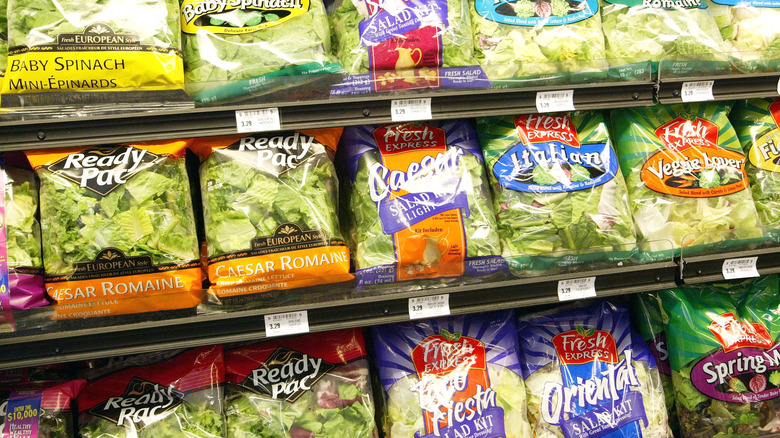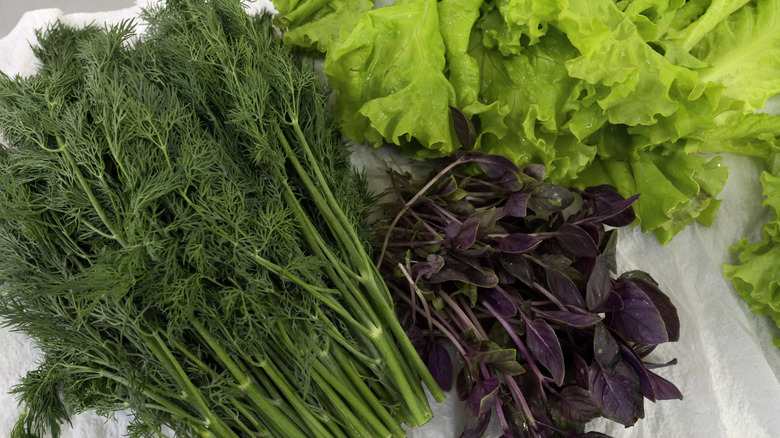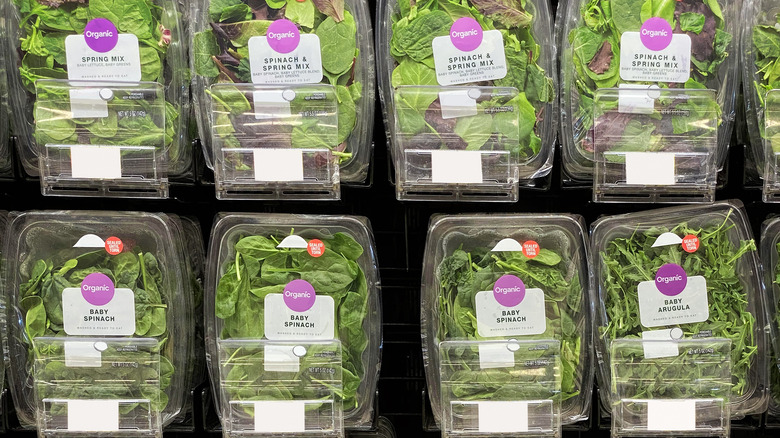The Bottom-Of-The-Bag Tip To Avoid Buying Slimy Greens
No grocery store item might be as divisive as bagged greens. Many home cooks swear that bagged lettuce is never worth buying at the grocery store due to how easily it wilts or seemingly gets infected with foodborne pathogens, as seen in a number of recent food recalls. But few people can deny that pre-packaged salad remains incredibly convenient, especially when you don't have the time to thoroughly wash and chop up a whole head of lettuce.
If you do choose to purchase a bag, you'll want to give yourself the best chance at selecting the freshest one available; a great way to check involves looking at the bottom of the bag they lettuce is stored in.
When selecting leafy greens at the grocery store, rotate the packaging to check for any signs of visible spoilage — including eyeing the bottom of the bag. Some signs to watch out for include changes in color, wilting leaves, and excess moisture pooling at the bottom of the bag or plastic container. As you rotate the bag around, try to spot the expiration date as well. Foods close to the end of their sellable period will either overtly show or start to develop signs of spoilage soon after purchase, so choose the youngest batch of chopped lettuce to take home to give yourself the best chance to use it.
Use a paper towel to keep your bagged greens fresh
Bagged greens are more susceptible to earlier rot for a key reason. According to the U.S. Food and Drug Administration, chopping leaves exposes their internal tissues to air and gives microbes an easier way of entry in comparison to whole heads of lettuce. This makes pre-packaged greens especially susceptible to warm, moist environments, which are considered the ideal setting for bacterial growth and spoilage. Refrigeration will take care of the warming problem, but there are a number of tricks and secrets about bagged salads that will prolong their life in your fridge. One such hack tackles the water problem, and it only requires a paper towel in order to wick up moisture.
After you've selected and purchased your leafy greens, place a cloth or paper towel inside the container they came in and promptly store them in the crisper drawer of your refrigerator. The rag will remove any excess humidity that develops inside the packaging, preventing your leaves from going bad right away. This won't work if your towel becomes soaked from all the condensation it will absorb over time, so make sure to replace it whenever it appears too damp. As you check for dampness, you should also remove any droopy leaves that appear to have started to perish, as they can accelerate the deterioration of the rest of your food through close exposure.
Other tips when buying pre-packaged lettuce
Not all leafy greens share the same levels of endurance. Delicate, young variants such as baby arugula won't last longer than five days in the fridge, so skip on these if you're not planning on using them within the week. Escarole, kale, and watercress are much sturdier by comparison, and can last up to two weeks if refrigerated properly. Regardless of which salad variety you choose, always remember that pre-packaged produce usually doesn't stay fresh more than a week, so expect even the hardiest leaves to wilt and spoil in that timeframe.
Another key point: Vegetables from a single region are regularly harvested throughout the whole year. To keep up with demand, many stores import their goods from various locations, and bagged greens are no exception. Since transportation accounts in the narrow time window where these pre-cut items stay good, you'll want to purchase in-season, local produce as often as you can. These have usually spent less time traveling and therefore have a much longer window before expiration, giving you more wiggle room to stretch their use out over the week.



